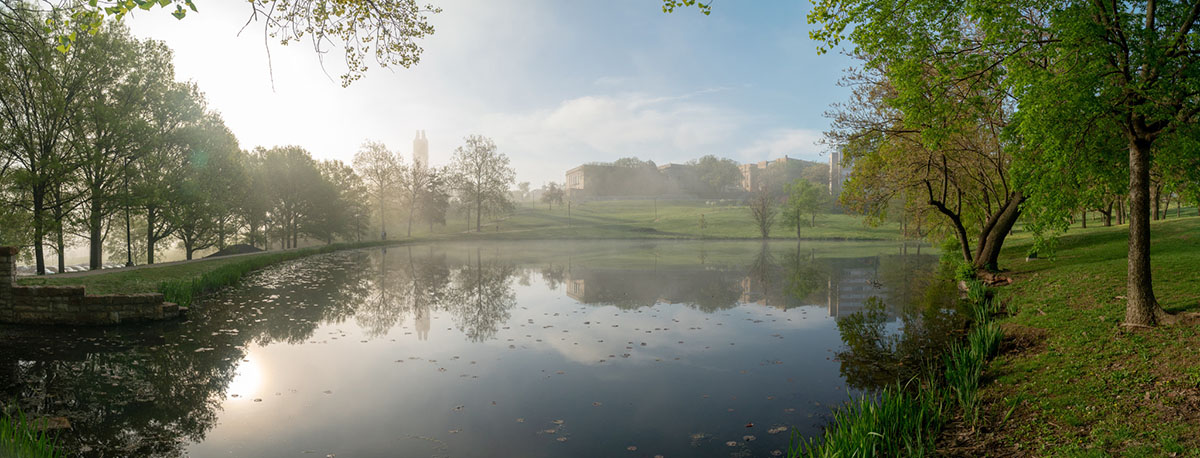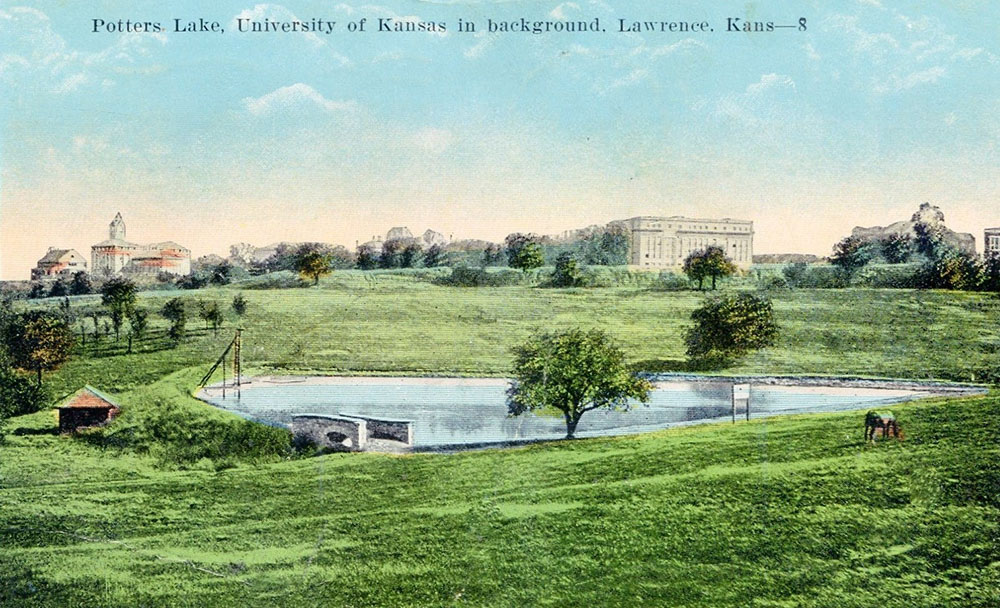University plans summer makeover for Potter Lake

LAWRENCE — Despite occasional practice to the contrary, the original intent of Potter Lake was not a repository for goal posts. The iconic University of Kansas Lawrence campus feature was actually created for a more noble purpose: to protect campus buildings.
Originally built to provide water for fighting fires, Potter Lake was also a popular swimming hole in its early days. For a number of reasons, though, the health of Potter has been a concern for much of its life.
This summer, Potter Lake is getting a makeover for its 113th birthday. A major project will begin this month to dredge the lake, rebuild portions of the original edge wall, and improve the spillway and sediment basin.
“The planned work will improve the functionality of Potter Lake, helping to ensure future health and make it a better environment for social, academic and research activities,” said Mark Reiske, director of facilities planning and development.

Like many rehab projects, things will look worse before they look better. Home renovations often begin with demolition, and Potter Lake’s extreme makeover will see a similar start. After graduation, an external contractor will begin dredging sediment, muck and water from Potter. Part of the work each day will be to collect turtles, frogs, snakes and other reptiles and relocate them to a pond in KU’s West District.
In addition to preparing Potter Lake for a new, healthier life, the dredging process has other environmental benefits, as the extracted nutrient-rich material will be sold to area farmers to spread on their fields.
After most of the water and sludge is gone, mechanical excavation will remove mud to lower the lake bed to a healthier depth. Originally an estimated 18 feet deep in spots, erosion has carried soil from the surrounding slopes to make Potter Lake shallower. This shallower lake bed creates a number of problems, including the proliferation of lily pads and a lack of oxygen needed for a healthy ecosystem. The dredging, along with other improvements, should help preserve the long-term health of Potter Lake.
“Potter Lake is suffering from the equivalent of morbid obesity,” said Bob Hagen, lecturer in environmental studies and a courtesy faculty member in ecology & evolutionary biology. “The work this summer to remove accumulated sediments and nutrients is necessary. The next challenge is to reshape the pond and its surroundings to reduce the rate at which fresh sediment and nutrients accumulate.”
The reconstruction work is expected to be complete by start of fall semester; however, Potter Lake won’t be fully restored immediately. It will take an estimated 12-18 months for rain and melting snow to refill Potter. The natural process is more environmentally responsible and less expensive than using the approximately 4 million gallons of treated city water required — the amount of water an average Lawrence household would use in 78 years.
Bonnie Johnson, director and professor in urban planning, and Hagen organized an ad hoc group of stakeholders to provide a vision for the future of Potter Lake, along with guidance on the restoration project.
“We assembled 14 ‘Super Friends’ of Potter Lake from environmental studies; ecology & evolutionary biology; architecture; geography; professional studies; English; civil, environmental & architectural engineering; and urban planning,” Johnson said.
The group focused on how to best preserve Potter Lake as an outdoor classroom, laboratory, art studio and calm green space. Johnson said for Potter Lake to continue these essential roles there needs to be nature in and around the pond. That is particularly important for Potter Lake’s role as an outdoor experiential classroom.
Hagen uses Potter Lake in teaching his KU students and groups of K-12 students.
“Potter Lake serves as a living laboratory where students in natural science courses can learn how ponds function and how they are connected to the surrounding areas,” he said.
Johnson also uses Potter Lake and the surrounding area in her courses. Even the restoration project itself is a learning opportunity. Johnson’s class of public administration students learned how to write a request for proposals for consulting firms to create plans to restore Potter Lake.
“The restoration offers students even more opportunities to learn engineering, habitat creation and long-term maintenance of culturally significant green spaces that can serve future communities well as our graduates go on to their careers and civic lives,” Johnson said.
A portion of the $1.2 million restoration project cost will be funded by a donation in memory of a former student who valued the beauty and serenity of Potter Lake.
Like that former student, current student Katie Payne goes to Potter Lake to relax and enjoy the outdoors.
“Potter Lake is a place where I know I can wind down and have a good time with friends. I love lying on the grass and letting the sun beat down on me as I hear the bells from the Campanile ring,” Payne said.
Thousands of students, faculty, staff and visitors since 1911 have relaxed on the banks, posed for pictures on the bridge and enjoyed quiet moments of reflection on the slopes surrounding Potter Lake. The restoration project this summer will preserve and enhance this campus treasure for future Jayhawks.
“In campus surveys conducted during our 2024 Master Plan process, Potter Lake was identified as one of the favorite outdoor spaces on campus,” Reiske said. “It is an iconic spot for campus memories, including graduation photos, marriage proposals and more. The restoration work will make Potter Lake even more beautiful for generations to come.”
Learn more about the history of Potter Lake.